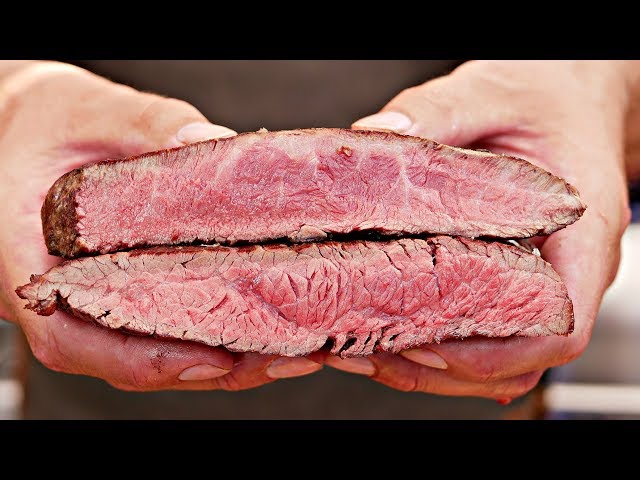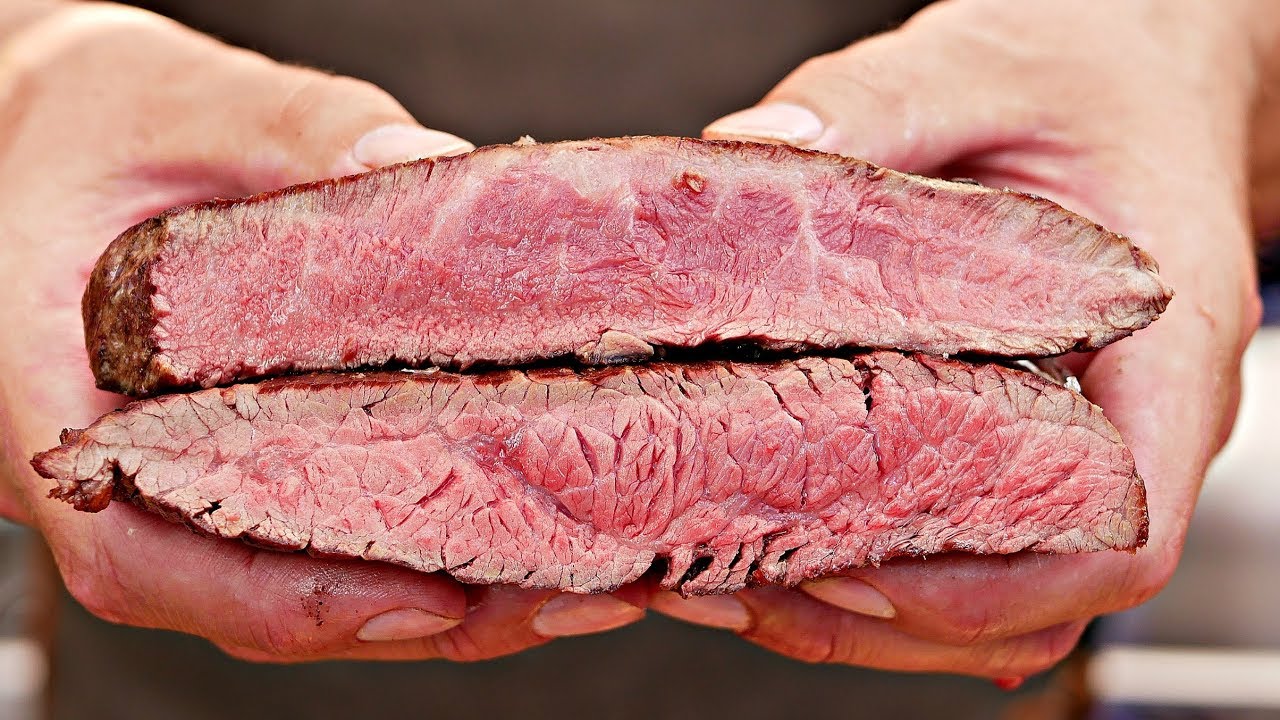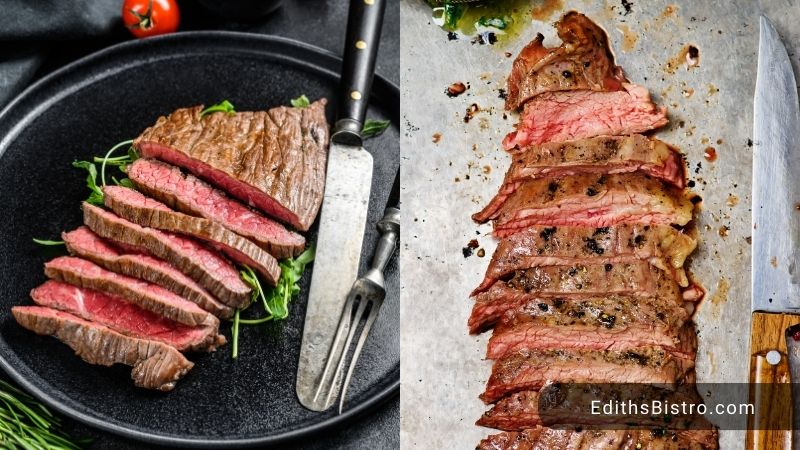What Makes Flank And Flat Iron Steak Different?

Flank and flat iron steak may both be delicious cuts of beef, but they have distinct differences. The main contrast lies in the location of the cuts on the cow and their texture. Flank steak comes from the abdominal muscles of the cow and is leaner, making it ideal for marinating and grilling. On the other hand, flat iron steak is sourced from the shoulder area and contains more marbling, resulting in a more tender and flavorful meat. These variations in cut and texture offer unique cooking and flavor profiles for different culinary preferences.
A Flank Steak: Characteristics And Flavor
A flank steak is known for its lean and flavorful characteristics. It is a long, flat piece of meat with prominent muscle fibers. This cut offers a bold and beefy taste, making it a favorite for grilling and marinating. The texture of flank steak is slightly chewy, but when cooked properly, it becomes tender and juicy. Its bold flavor pairs well with marinades and spices, allowing for versatile and delicious meal options. Whether used in fajitas, stir-fries, or as the star of a juicy steak sandwich, flank steak offers a satisfying beefy experience.
B Flat Iron Steak: Characteristics And Flavor
The flat iron steak is known for its tenderness and rich flavor. It comes from the shoulder area of the cow and has a distinctive marbling pattern. This marbling provides an excellent source of flavor and juiciness. The flat iron steak has a velvety texture that melts in your mouth when cooked to medium-rare. Its versatility allows it to be grilled, broiled, or seared, making it a great choice for various cooking methods. Whether served as a steak on its own or sliced for salads or sandwiches, the flat iron steak offers a succulent and delicious dining experience.
Cooking And Preparation Methods For Flank And Flat Iron Steak

When it comes to cooking and preparing flank and flat iron steak, there are various methods to consider. For flank steak, marinating is highly recommended to enhance its tenderness and flavor. Grilling is a popular cooking method for flank steak, as it helps to bring out its natural juiciness. Searing is another great option for flat iron steak, as it creates a delicious crust on the outside while keeping the inside tender and juicy. Both cuts can also be broiled or pan-seared for a quick and flavorful meal. Ultimately, the choice of cooking method depends on personal preference and desired level of doneness.
A Grilling Flank Steak: Tips And Techniques
When it comes to grilling flank steak, there are a few tips and techniques to ensure a juicy and delicious result. First, it’s important to properly marinate the steak for at least 4-6 hours or overnight to enhance its tenderness and flavor. Preheat the grill to high heat and oil the grates to prevent sticking. Cook the flank steak for about 4-6 minutes per side, depending on your desired level of doneness. Let the steak rest for a few minutes before slicing against the grain to maximize tenderness. Enjoy your perfectly grilled flank steak!
B Searing Flat Iron Steak: Tips And Techniques
When it comes to searing a flat iron steak, there are a few key tips and techniques to ensure a delicious and perfectly cooked result. First, make sure the steak is at room temperature before cooking to ensure even cooking. Preheat a cast iron skillet or grill pan over high heat to get a nice sear. Season the steak with salt and pepper, and coat it with a high smoke point oil like canola or avocado oil. Sear the steak for about 3-4 minutes per side, or until it reaches your desired level of doneness. Let the steak rest for a few minutes before slicing against the grain to maximize tenderness. Enjoy your flavorful and juicy seared flat iron steak!
Flank Steak Recipes

Flank steak is a versatile cut of meat that lends itself well to a variety of delicious recipes. Here are two flavorful options to try:
- Garlic-Marinated Grilled Flank Steak: Create a marinade with minced garlic, soy sauce, olive oil, honey, and your favorite herbs and spices. Let the steak marinate for at least 2 hours, then grill it over high heat for about 4-5 minutes per side for medium-rare. Let it rest before slicing against the grain.
- Asian-inspired Stir-Fried Flank Steak: Slice the flank steak into thin strips and marinate it in a mixture of soy sauce, sesame oil, ginger, and garlic. Stir-fry the steak in a hot wok with vegetables like bell peppers, carrots, and broccoli. Serve over rice or noodles.
These recipes showcase the tenderness and flavor of flank steak in different culinary styles. Enjoy!
A Garlic-marinated Grilled Flank Steak
To enhance the flavor of flank steak, a garlic-marinated grilled preparation is the way to go. Start by creating a marinade with minced garlic, soy sauce, olive oil, honey, and your favorite herbs and spices. Let the steak marinate for at least 2 hours to allow the flavors to penetrate the meat. Then, grill it over high heat for about 4-5 minutes per side for a medium-rare doneness. This grilling method brings out the natural tenderness of the flank steak while infusing it with a savory garlic flavor. Serve it with your favorite side dishes for a delicious and satisfying meal.
B Asian-inspired Stir-fried Flank Steak
To add an Asian twist to your flank steak, try making an Asian-inspired stir-fry. Begin by thinly slicing the flank steak against the grain to ensure tenderness. Heat a wok or skillet over high heat and add some vegetable oil. Stir-fry the flank steak with a combination of vegetables such as bell peppers, broccoli, and carrots. Flavor the stir-fry with a mixture of soy sauce, ginger, garlic, and sesame oil. Cook until the steak is cooked to your desired doneness and the vegetables are crisp-tender. Serve over steamed rice or noodles for a delicious and flavorful meal.
Flat Iron Steak Recipes

Flat Iron Steak is a versatile cut of meat that can be cooked in various delicious ways. One popular recipe is Chimichurri Flat Iron Steak, where the steak is marinated in a flavorful blend of parsley, garlic, vinegar, and olive oil, and then grilled to perfection. Another tasty option is Pan-Seared Flat Iron Steak with Roasted Vegetables. This recipe involves searing the steak in a hot skillet until it is nicely browned, and serving it with a side of roasted vegetables such as carrots, potatoes, and Brussels sprouts. These recipes will surely impress your family and friends with their tender and flavorful results.
A Chimichurri Flat Iron Steak
A Chimichurri Flat Iron Steak is a mouthwatering and flavorful dish that showcases the tenderness of the flat iron steak. The steak is marinated in a delicious blend of fresh parsley, garlic, vinegar, and olive oil, giving it a tangy and herbaceous flavor. The marinade infuses the steak with bold and vibrant flavors, complementing the rich and juicy meat. After marinating, the steak is grilled to perfection, resulting in a tender and succulent dish. Served with a drizzle of chimichurri sauce, this flat iron steak recipe is sure to impress your guests and satisfy your taste buds.
B Pan-seared Flat Iron Steak With Roasted Vegetables
For a delicious and well-rounded meal, try pan-seared flat iron steak with roasted vegetables. This recipe combines the rich flavors of the flat iron steak with the wholesome goodness of roasted vegetables. Start by seasoning the steak with salt, pepper, and your choice of herbs. In a hot skillet, sear the steak on both sides until it reaches your desired level of doneness. While the steak rests, roast a medley of vegetables like carrots, potatoes, and Brussels sprouts in the oven with olive oil, salt, and pepper. Serve the juicy steak alongside the tender and caramelized vegetables for a satisfying and nutrient-packed dinner.
Choosing Between Flank And Flat Iron Steak

When it comes to choosing between flank and flat iron steak, there are a few factors to consider. First, think about the texture and tenderness you prefer. Flank steak is leaner and has a more fibrous texture, while flat iron steak is tender and juicy. Second, consider the flavor and cooking techniques you enjoy. Flank steak is great for marinating and grilling, while flat iron steak is best cooked medium-rare with a quick sear. Ultimately, the decision comes down to personal preference and the specific dish you are planning to make.
A Considerations For Texture And Tenderness
When choosing between flank and flat iron steak, texture and tenderness are important factors to consider. Flank steak is leaner and has a more fibrous texture, making it slightly tougher compared to the flat iron steak. On the other hand, flat iron steak is known for its exceptional tenderness, thanks to its marbling and location on the shoulder area. If you prefer a tender steak, flat iron is the way to go. However, if you enjoy a slightly chewier texture, flank steak may be your preference.
B Factors To Consider For Flavor And Cooking Techniques
When it comes to flavor and cooking techniques, there are several factors to consider when choosing between flank and flat iron steak.
- Flavor: Flank steak has a rich, beefy flavor, while flat iron steak is known for its intense beefy taste with a hint of sweetness.
- Cooking Techniques: Flank steak is best marinated and cooked quickly over high heat, such as on a grill or in a hot pan. Flat iron steak can be grilled, pan-seared, or broiled to retain its tenderness and juiciness.
- Seasoning: Both steaks can be enhanced with a variety of seasonings, such as garlic, herbs, or spices, to complement their natural flavors.
- Resting Time: After cooking, both steaks should be allowed to rest for a few minutes to redistribute the juices and ensure maximum tenderness.
By considering these factors, you can choose the steak that best suits your desired flavor profile and cooking preferences.
Conclusion

In conclusion, choosing between flank and flat iron steak ultimately depends on personal preferences. Flank steak offers a rich, beefy flavor and is ideal for dishes like fajitas. On the other hand, flat iron steak boasts intense beefy taste with a hint of sweetness and works well in various cooking techniques, including grilling and pan-searing. Both cuts can be delicious when prepared correctly and paired with the right seasonings. By considering factors such as texture, tenderness, flavor, and cooking techniques, individuals can make an informed decision and enjoy a flavorful and satisfying meal.
A Recommended Uses And Dishes For Flank And Flat Iron Steak
Flank and flat iron steak have their own unique qualities that make them suitable for different dishes. Flank steak is perfect for dishes like fajitas, stir-fries, and tacos due to its rich, beefy flavor and ability to absorb marinades. On the other hand, flat iron steak is ideal for grilling, pan-searing, or even using in steak salads. Its tender texture and intense beefy taste pair well with bold marinades or sauces like chimichurri. Whether you’re looking for a flavorful filling for tacos or a juicy steak for grilling, both flank and flat iron steak offer versatile options for delicious meals.
B Summary And Final Thoughts
In summary, choosing between flank and flat iron steak comes down to personal preferences and the specific dish you’re preparing. Flank steak offers a rich, beefy flavor and is perfect for marinating and using in dishes like fajitas and stir-fries. On the other hand, flat iron steak is known for its tenderness and intense beefy taste, making it ideal for grilling or pan-searing. Both cuts offer delicious options for a variety of dishes, so it ultimately comes down to the texture, flavor, and cooking techniques you prefer. Happy cooking!
Flank vs. Flat Iron Steak – Frequently Asked Questions
Q: What is the difference between flank steak and flat iron steak?
A: Flank steak and flat iron steak are both flavorful cuts of beef, but they come from different parts of the animal. Flank steak is cut from the abdominal muscles of the cow, while flat iron steak is obtained from the shoulder blade area.
Q: Which cut is more tender, flank or flat iron steak?
A: Flat iron steak is generally more tender than flank steak. The flat iron steak is known for its tenderness, marbling, and fine texture, making it an excellent choice for grilling, broiling, or pan-searing. Flank steak, on the other hand, is a leaner cut that can be a bit tougher. It is best when cooked quickly at high temperatures and sliced thinly against the grain to maximize tenderness.
Q: Are there any differences in flavor between the two cuts?
A: Yes, there are subtle differences in flavor between flank and flat iron steak. Flat iron steak has a rich, beefy flavor with good marbling, which adds to its overall taste. Flank steak, although lean, has a robust flavor with a slightly stronger beefy taste. Both steaks are prized for their unique flavors, but if you prefer a more tender and marbled cut, flat iron steak may be your choice.
Q: How should I cook flank and flat iron steaks?
A: Due to their different textures, cooking methods may vary. Flat iron steak is best cooked using high-heat dry cooking methods such as grilling, broiling, or pan-searing to medium-rare or medium doneness for optimum tenderness and juiciness. Flank steak is commonly marinated to help tenderize it and is best cooked quickly over high heat, such as on a hot grill or under the broiler, to a medium rare or medium level of doneness.
Q: Can I interchange flank and flat iron steak in recipes?
A: While both cuts can be delicious, it’s important to note that they have different textures and cooking characteristics. Substituting one for the other may affect the outcome of your recipe. Flat iron steak can usually be used as a substitute for flank steak due to its tenderness and similar taste, but the reverse may not always be possible. It’s best to follow the recipe recommendations or consult a culinary expert for guidance on substituting these cuts.
Q: Are there any special tips for cooking flank and flat iron steaks?
A: Yes, here are a few tips to enhance your cooking experience:
- When grilling flank steak, marinate it for at least 30 minutes to overnight to improve tenderness and flavor.
- For flat iron steak, ensure a hot grill or skillet and a medium-rare or medium doneness level to maintain its tenderness.
- Always slice flank steak against the grain (fibers) after resting to ensure optimal tenderness.
- Let both steaks rest for a few minutes after cooking to allow the juices to redistribute and maintain their juiciness.
In conclusion, both flank steak and flat iron steak have their unique qualities and flavors. Flat iron steak tends to be more tender and marbled, while flank steak offers a robust flavor and leaner texture. Choosing the right cut depends on your preference and the recipe you plan to create.

From At-Home Dinner Parties to Family Reunions to Office Parties, we can cater your next Event!